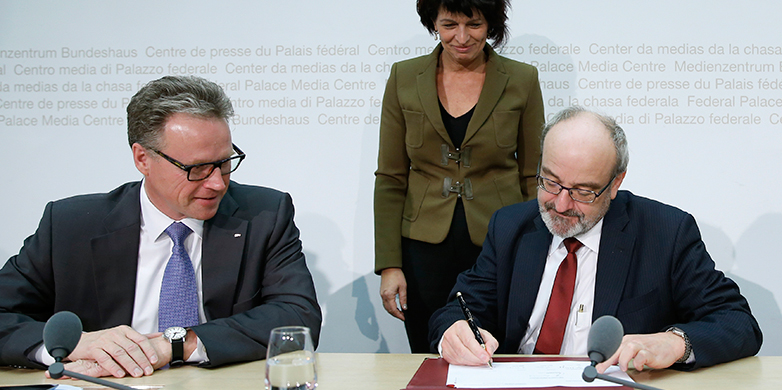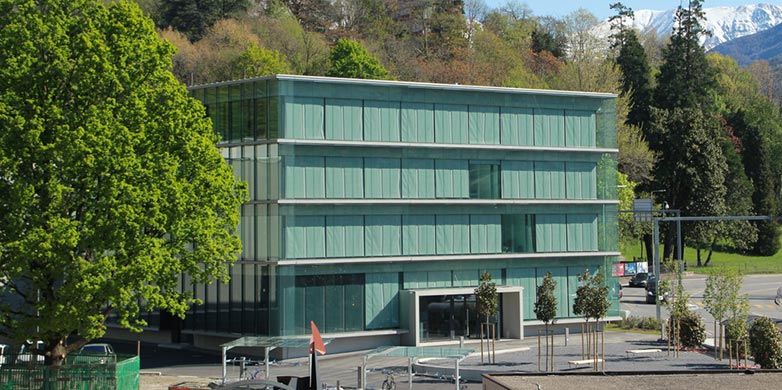Increasing energy efficiency and stepping up energy research in the ETH Domain
The Swiss Federal Administration, the ETH Domain and the parastate enterprises SBB, Swiss Post, Swisscom and Skyguide are aiming to further improve their energy efficiency in future. To this end, a package of measures is being planned as part of the Energy Strategy 2050.
The Swiss Federal Administration, the ETH Domain and the parastate enterprises have an example to set when it comes to using environmental and energy resources. Together, they account for around two per cent of Switzerland’s energy consumption. For several years now, the Federal Administration, SBB, Swiss Post, Swisscom and Skyguide have been endeavouring to boost their energy efficiency and reduce their consumption levels – and they are ready to step up these efforts even further in future.
As part of the Energy Strategy 2050, the Swiss Federal Council is planning a package of measures aimed at achieving a 25 per cent increase in the energy efficiency of the Federal Administration, various government-affiliated organisations and the ETH Domain by 2020 when compared with 2006.
On Thursday, as announced by the Federal Council, Federal Councillor Doris Leuthard, Andreas Meyer (CEO of SBB), Susanne Ruoff (CEO of Swiss Post), Urs Schaeppi (CEO of Swisscom), Daniel Weder (CEO of Skyguide) and President of the ETH Board Fritz Schiesser signed a joint letter of intent to underline their intentions in this regard.
An increase in energy efficiency in the ETH Domain
The ETH Domain – which comprises ETH Zurich, EPF Lausanne and the research institutes Empa, Eawag, the Swiss Federal Institute for Forest, Snow and Landscape Research (WSL) and the Paul Scherrer Institute – is seeing a rise in student numbers and has some energy-intensive large-scale research facilities to maintain. Meanwhile, its education and research activities have expanded into new fields of research and technology.
In spite of this growth, the Federal Council reports that the ETH Domain’s energy consumption per capita has fallen and its energy efficiency level has increased. According to the ETH Domain’s energy efficiency targets, it is aiming to improve its efficiency by at least 20 per cent by 2020 compared to 2006.
The ETH Domain has already seen a 15 per cent improvement in energy efficiency between 2006 and 2013, thanks to initiatives such as the construction of the new Swiss National Supercomputing Centre (CSCS) in Lugano, which is one of the most energy-efficient data centres in the world.
In terms of energy research, the ETH Domain is making targeted investments in training and education, science and the direct transfer of technology into industry. As well as introducing new study programmes and research projects, the Federal Council has stated that the ETH Domain will play a leading role in establishing the new national competence centres for energy research.
Energy research: a core area of expertise
According to the ETH Board, the key to the ETH Domain’s contribution towards the success of the Energy Strategy 2050 lies in one of the core areas of expertise of its two universities and four research institutes: energy research. This has been one of the main fields of research within the ETH Domain for many years now and covers the entire value chain – from fundamental research to product-oriented development, which, as the ETH Board points out, benefits industry and innovative SMEs in Switzerland
Energy-efficient processes and the reduction of CO2 emissions are at the forefront of energy research in the ETH Domain. More than 70 per cent of the funding available to the ETH Domain for energy research is channelled into investigating renewable energy sources and energy efficiency.
ETH Zurich also runs its own competence centre for sustainable energy research, the Energy Science Center, which has links with a total of 57 professorships. On top of this, it offers two energy-oriented Master’s degree programmes: the Master’s degree in Integrated Building Systems and the Master’s degree inEnergy Science and Technology.
The ETH Domain also has a leading role to play in the new national competence centres for energy research (external pageSwiss Competence Centers for Energy Research, SCCERcall_made). These will focus on the top-priority areas of action for energy research – such as energy efficiency, energy systems, storage and mobility. Three of them will be run under the overall management of ETH Zurich:
- the SCCER for energy-efficient industrial processes (led by Philipp Rudolph von Rohr from the Department of Mechanical and Process Engineering, D-MAVT),
- the SCCER for efficient concepts, processes and components in mobility (led by Konstantinos Boulouchos, also from D-MAVT) and
- the SCCER on power supply (led by Domenico Giardini from the Department of Earth Sciences, D-ERDW).
Energieversorgung 2050: Intergration oder Inseldenken? (Energy supply in 2050: integration or an insular approach?)
Event at ETH Zürich
Thursday 11 December 2014, 3.00 p.m. – 6.30 p.m.
ETH Main Building, HG F 30 (Audimax)
More information in German can be found on the website of the Energy Science Center (ESC) at ETH Zurich.


